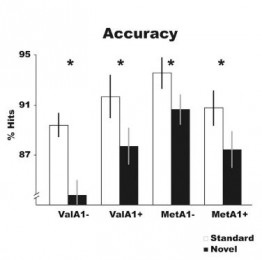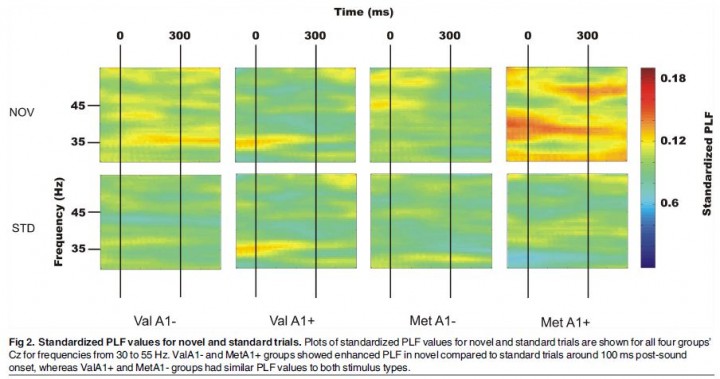The journal PLOS ONE has published online on February 21st, 2017, another paper from the Brainlab. The paper is entitled COMT and DRD/ANKK-1 gene-gene interaction account for resetting of gamma neural oscillations to auditory stimulus-driven attention, and co-authored by Manuel Garcia-Garcia. Marc Via, Katarzyna Zarnowiec, Iria SanMiguel, Carles Escera and Immaculada Clemente.

Using a well-established auditory-visual distraction protocol (see Escera et al., 1998), in this study we demonstrate that phase-resetting of gamma neural oscillations underlies stimulus-driven attention, which in turn is dependent on the epistatic interaction between genetic polymorphisms associated with dopamine neurotransmission (namely, COMTVal108/158Met and ANKK1/DRD2 TaqIa).

The full abstract reads as follows:
Full refeAttention capture by potentially relevant environmental stimuli is critical for human survival, yet it varies considerably among individuals. A large series of studies has suggested that attention capture may depend on the cognitive balance between maintenance and manipulation of mental representations and the flexible switch between goal-directed representations and potentially relevant stimuli outside the focus of attention; a balance that seems modulated by a prefrontostriatal dopamine pathway. Here, we examined inter-individual differences in the cognitive control of attention through studying the effects of two single nucleotide polymorphisms regulating dopamine at the prefrontal cortex and the striatum (i.e., COMTMet108/158Val and ANKK1/DRD2TaqIA) on stimulus-driven attention capture. Healthy adult participants (N=40) were assigned to different groups according to the combination of the polymorphisms COMTMet108/158Val and ANKK1/DRD2TaqIA, and were instructed to perform on a well-established distraction protocol. Performance in individuals with a balance between prefrontal dopamine display and striatal receptor density was slowed down by the occurrence of unexpected distracting events, while those with a rather unbalanced dopamine activity were able maintain task performance with no time delay, yet at the expense of a slightly lower accuracy. This advantage, associated to their distinct genetic profiles, was paralleled by an electrophysiological mechanism of phase-resetting of gamma neural oscillation to the novel, distracting events. Taken together, the current results suggest that the epistatic interaction between COMTVal108/158Met and ANKK1/DRD2 TaqIa genetic polymorphisms lies at the basis of stimulus-driven attention capture.
Full reference:
Garcia-Garcia, M., Via, M., Zarnowiec, K., SanMiguel, I., Escera, C., & Clemente, I.C. (2016). COMT and DRD/ANKK-1 gene-gene interaction account for resetting of gamma neural oscillations to auditory stimulus-driven attention. PLoS ONE, 12(2): e01072362. Doi:10.1371/journal.pone.0172362.

